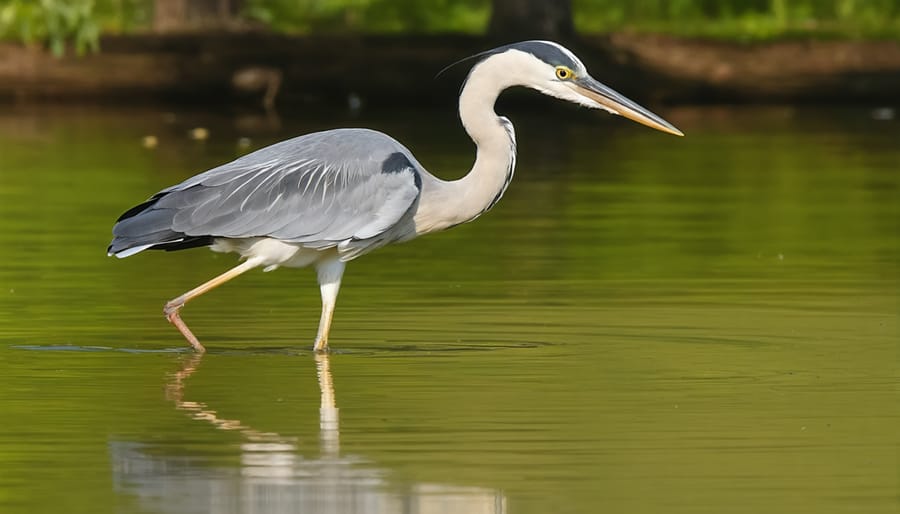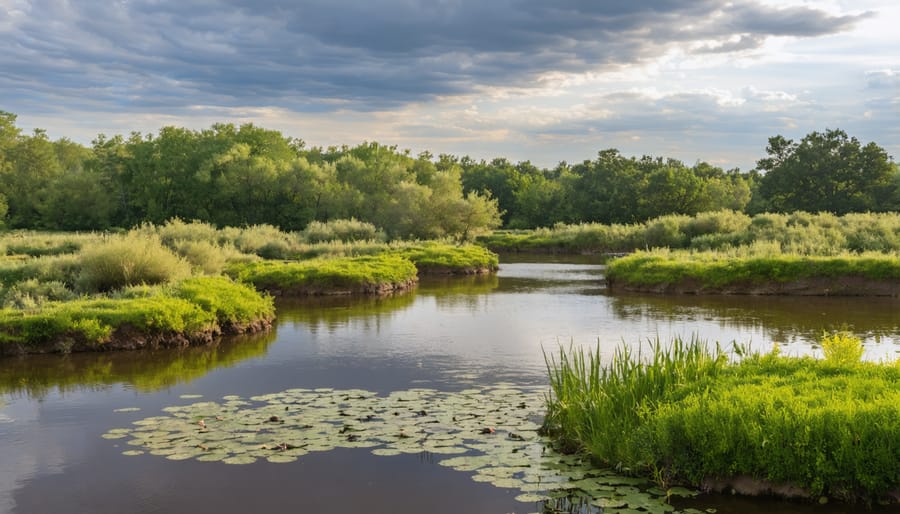
Why Your Pond Fish Keep Disappearing (The Genetics Behind Predator Behavior)
# How Genetics Influence Behavior: Understanding Your Pond’s Predators
You’ve invested hours creating the perfect backyard pond, stocked it with beautiful koi, and then one morning—disaster strikes. A heron has helped itself to breakfast, or a raccoon has left muddy prints around your decimated water garden. Here’s what most pond owners don’t realize: these predators aren’t acting out of spite or randomness. They’re following genetic programming that’s been refined over millions of years.
Think of genetics as the instruction manual every creature is born with. Just like you instinctively pull your hand away from something hot, herons are genetically wired to hunt in shallow water at dawn, and raccoons are programmed to “wash” their food and explore with their incredibly sensitive paws. These aren’t learned behaviors—they’re coded into their DNA, passed down through countless generations because they helped their ancestors survive.
Understanding these genetic blueprints changes everything about pond protection. When you know *why* a predator behaves a certain way, you can outsmart those ancient instincts instead of just reacting to attacks. That heron standing statue-still at your pond’s edge? Its genes tell it to hunt where it can see fish clearly. Those nocturnal raccoon visits? Genetics drive them to forage near water sources when competition is lowest.
This isn’t abstract science—it’s practical knowledge that helps you predict, prevent, and protect. Let’s explore how genetics shape predator behavior and, more importantly, how you can use this understanding to finally safeguard your pond.
The Science Made Simple: What Genetics Actually Means for Your Pond
Think of genetics as a recipe book that every living creature inherits from its parents. Just like your grandmother’s famous pie recipe includes specific instructions for the perfect crust, a heron’s genes contain “instructions” for behaviors like stalking fish in shallow water. These genetic blueprints don’t control every single action, but they create strong tendencies—natural inclinations that make certain behaviors come more easily.
Here’s where it gets interesting for your pond: predators like raccoons, herons, and cats are born with what I call “hunting software” already installed. A young heron doesn’t need to attend fishing school—its genes provide the basic programming for patient waiting, quick striking, and recognizing fish-shaped movement. This is inherited behavior, passed down through countless generations of successful hunters.
However, genetics isn’t destiny—it’s more like a starting point. Think of it this way: if genetics loads the software, experience provides the upgrades. A raccoon is genetically wired to use its incredibly sensitive paws to feel for food underwater, but through learned behavior, it discovers that *your* pond has easy-to-catch goldfish at the shallow end near those decorative rocks.
This combination matters enormously when you’re protecting your pond. You’re not just dealing with random animal visits—you’re facing creatures whose ancestors have been perfecting hunting techniques for thousands of years. Their genetic programming makes them persistent, patient, and remarkably good at problem-solving around obstacles.
Understanding this helps explain why a simple scarecrow rarely works for long. You’re working against deeply ingrained genetic drives, reinforced by learned success. The good news? Once you understand what you’re up against, you can design defenses that work *with* these behavioral patterns rather than just hoping predators will forget your pond exists.

Meet Your Pond’s Most Common Predators
Herons and Kingfishers: Born to Hunt
If you’ve ever watched a heron standing motionless at your pond’s edge or spotted a kingfisher dive-bombing from overhead, you’re witnessing millions of years of evolution at work. These beautiful birds aren’t just visiting your pond by chance—they’re hardwired to hunt fish, and it’s all written in their DNA.
Herons possess genetic traits that make them perfect fishing machines: incredible patience encoded in their neural pathways, lightning-fast strike reflexes, and specialized vision that helps them compensate for light refraction in water. Their neck muscles contain a unique “spring-loaded” mechanism that lets them strike with remarkable speed and accuracy.
Kingfishers are equally impressive, with genetic adaptations for their signature diving technique. Their eyes have special oils that help them see underwater, and their beak shape is aerodynamically designed for clean water entry—nature’s perfect spear-fishing tool.
Here’s what this means for your pond: these birds aren’t being stubborn or malicious when they keep returning despite your deterrent efforts. They’re simply following deeply ingrained behavioral patterns that have ensured their species’ survival for millennia. Understanding this genetic programming is your first step toward developing more effective, compassionate protection strategies.
Raccoons: The Clever Night Raiders
If you’ve ever watched a raccoon work, you’ll notice they’re not just cute bandits—they’re determined problem-solvers with genetics on their side. Those nimble front paws? They’re packed with tactile receptors that let raccoons “see” with their hands, especially underwater. This genetic trait makes them incredibly effective at catching fish and frogs without even looking!
Their persistence isn’t just stubbornness—it’s hardwired. Raccoons possess exceptional spatial memory, genetically programmed to remember food sources for months. Once they discover your pond, they’ll keep returning, even testing different entry points each night. This behavior stems from their opportunistic foraging genes, which helped their ancestors survive by maximizing every food opportunity.
Here’s the tricky part: raccoons are genetically disposed to learn from experience. They’ll figure out your deterrents over time, adapting their approach. I’ve seen raccoons learn to bypass motion sensors by approaching from different angles, and even remember seasonal patterns—returning each spring when fish are spawning and most vulnerable. Understanding this genetic cleverness helps explain why protecting your pond requires multiple, rotating strategies rather than a single solution.

Cats and Other Surprise Visitors
Your neighborhood cat isn’t being malicious when it eyes your pond—it’s simply following thousands of years of hardwired hunting instincts! Domestic cats retain their wild ancestors’ predatory drive, making your colorful koi and goldfish irresistible moving targets. Their genetics tell them to stalk, pounce, and catch.
Raccoons are another surprise visitor driven by innate foraging behaviors. These masked bandits have incredibly dexterous paws and problem-solving abilities coded into their DNA, allowing them to overcome many pond defenses. I’ve watched raccoons methodically work around barriers I thought were foolproof!
Snakes, depending on your region, may also visit based on their genetic programming to hunt fish and amphibians. Even neighborhood dogs might splash through your pond, their prey drive triggered by fast-moving fish.
Understanding that these animals aren’t being “bad”—they’re simply doing what their genetics programmed them to do—helps us create more effective, humane deterrents rather than getting frustrated with nature.
The Genetic Blueprint: Why Predators Can’t Help Themselves
The Hunting Instinct: It’s in Their DNA
Here’s something that might surprise you: even if your neighborhood heron just finished a full breakfast elsewhere, it’ll still eye your prized koi like they’re an irresistible dessert. That’s because hunting isn’t really about hunger—it’s hardwired into their genetic code.
Think of prey drive as nature’s ancient programming that’s been refined over millions of years. When a raccoon spots movement in your pond or a cat notices a flash of orange beneath the water’s surface, their brain doesn’t pause to ask “Am I hungry?” Instead, their DNA kicks in with an automatic response: chase, catch, consume. It’s the same reason your well-fed house cat still stalks birds in the backyard.
This genetic programming exists because, in the wild, predators never know when their next meal might appear. Animals that hunted whenever opportunity knocked—regardless of their current hunger level—survived and passed those genes along. Those that waited until they felt picky about meals? They didn’t make it.
For us pond keepers, this means we can’t rely on the “maybe they’re not hungry” defense. Your beautiful goldfish trigger these ancient instincts simply by existing. Understanding this helps explain why deterrents work better than hoping predators will lose interest—because genetically speaking, they simply can’t. Their DNA won’t let them ignore what evolution has trained them to pursue.
Visual Triggers: What Catches a Predator’s Eye
Predators don’t just randomly attack your pond fish—they’re genetically hardwired to spot specific visual cues that scream “easy meal!” Understanding these built-in triggers can help you protect your beloved koi and goldfish more effectively.
**Movement is the number one attention-grabber**. Herons, raccoons, and cats all inherit keen motion detection abilities from countless generations of successful hunters. When your fish dart near the surface or splash around during feeding time, they’re essentially waving a flag at any nearby predator. This is why still, deep ponds with minimal surface disturbance tend to be safer.
**Color contrast also plays a huge role** in making your fish visible targets. Bright orange goldfish or white koi stand out brilliantly against dark pond bottoms—exactly what a heron’s eyes evolved to detect from high above. Think about it: in nature, flashy colors often signal vulnerability or distraction. Hawks can spot a white mouse in brown grass from hundreds of feet up, and that same genetic programming helps herons zero in on your prized butterfly koi.
**Shape recognition matters too**. Predators instinctively recognize the torpedo-like silhouette of fish. When your pond has crystal-clear water and fish are swimming in shallow areas, they become easy targets for animals whose ancestors survived by quickly identifying prey shapes.
The good news? Once you understand these genetic triggers, you can use simple strategies like adding surface plants, creating deeper zones, and choosing less conspicuous fish colors to outsmart these hardwired hunting instincts.

Memory and Learning: When Genetics Meets Experience
Here’s the fascinating part: predators don’t just rely on instinct alone—they’re actually quite smart! While genetics give them the hunting drive and physical tools, their brains are hardwired to remember what works. Think of it like this: if you found a fantastic fishing spot that delivered results every time, you’d definitely bookmark it, right?
The same principle applies to herons, cats, and other pond predators. When a heron successfully catches a goldfish from your pond on Tuesday morning, its brain creates a powerful memory map. “Abundant food source detected at this exact location!” This isn’t just learned behavior—it’s genetics meeting experience. Their DNA programs them to remember successful hunting grounds, and once they’ve tagged your pond as a reliable restaurant, they’ll keep coming back.
I learned this the hard way when a local heron discovered my koi pond. After its first successful visit, it returned like clockwork every morning for a week! The bird wasn’t being vindictive—it was simply following its genetic programming combined with positive reinforcement. Each successful catch strengthened the memory pathway.
This memory formation is crucial for predator survival in nature, where understanding predator-prey relationships helps maintain ecosystem balance. Unfortunately for pond owners, it means once you’re discovered, you’ll likely face repeat visits until you actively change the equation by making your pond less accessible or rewarding.
Using Predator Genetics to Your Advantage: Protection Strategies That Actually Work
Design Tricks That Confuse Genetic Programming
Here’s where things get really exciting! Once you understand how predators are hardwired to hunt, you can outsmart their instincts with clever pond design elements that basically short-circuit their genetic programming.
Think about it this way: herons are programmed to wade into shallow water and strike downward. So what happens when you make your pond edges drop off steeply? The heron can’t access the fish! I learned this lesson after watching a heron visit my pond three mornings in a row. Once I added a sharp drop-off around the perimeter—going from ground level to about 60cm deep within just 30cm of distance—the visits stopped. The bird’s genetics tell it to hunt in shallow zones, and when those don’t exist, it moves on.
Overhangs work similarly with aerial predators like kingfishers. These birds dive from above, so strategic rock shelves or planted edges that jut over the water create blind spots their hunting instincts can’t compensate for. Your fish instinctively hide under these covers, and the predator’s genetic playbook doesn’t include “check under the ledge.”
Hiding spots like submerged pipes, dense aquatic plants, or stacked rocks exploit another genetic reality: predators prefer easy meals. When fish can vanish quickly, most predators won’t waste precious energy on a difficult hunt. Their genes drive them toward efficiency, and a well-designed pond makes your fish the inefficient choice.

Breaking the Pattern: Why Rotating Defenses Works
Here’s the thing about predators – they’re incredibly smart learners. I learned this the hard way when a heron figured out my scarecrow was fake in just three days! Predators have evolved to adapt quickly because their survival depends on it. Their genetics give them sharp memory and problem-solving abilities, which means any single defense method becomes less effective over time.
Think of it like this: if you always lock your front door but leave the back door open, eventually someone notices the pattern. Herons, raccoons, and cats do the same thing with your pond defenses. They observe, learn, and adapt. A motion-activated sprinkler might startle them initially, but after a few harmless encounters, they realize it’s no real threat.
The solution? Rotation is your secret weapon. By changing your defensive strategies every few weeks, you prevent predators from getting comfortable. Swap netting positions, move your decoys to different spots, alternate between sound deterrents and visual ones. This unpredictability keeps predators guessing and maintains their wariness. Combined with comprehensive year-round pond protection strategies, rotating defenses ensures your fish stay safe while predators move on to easier hunting grounds.
Creating an Unwelcoming Environment
Predators are naturally cautious creatures—their survival depends on weighing risk versus reward. When a heron spots your pond, its genetics kick in with a quick mental calculation: “Is this meal worth the danger?” Your goal is to tip that equation firmly in the “not worth it” direction.
Start by eliminating hiding spots where predators feel safe approaching. Trim back overhanging branches and dense vegetation around the pond’s perimeter—herons especially prefer stalking from cover. I learned this the hard way when I watched a heron casually wade in from behind my hostas!
Add unexpected movement to trigger their wariness instincts. Motion-activated sprinklers work wonderfully because they create unpredictable patterns that feel threatening. Reflective tape, spinning pinwheels, or floating decoys create visual disturbances that make predators nervous. The key is changing these deterrents regularly—predators are smart and will realize static defenses aren’t actual threats.
Consider your pond’s depth profile too. Shallow edges are hunting highways for wading birds. If possible, create steep drop-offs near the perimeter, making it difficult for herons to stand comfortably while fishing. This simple design tweak leverages their natural preference for easy, low-risk hunting grounds.
Real Stories from Real Ponds: Genetics in Action
I’ll never forget when my neighbor Martha called me over, practically dragging me to her pond. “You have to see this!” she exclaimed. A great blue heron was standing motionless at the water’s edge—for twenty minutes straight. We watched in amazement as it suddenly struck with lightning speed, nabbing one of her prized goldfish. Martha was frustrated, but it clicked for both of us: this wasn’t random. This bird was genetically programmed to be the ultimate fish-catching machine, and her pond was just too tempting.
Another pond keeper I know, Tom, shared a fascinating observation. He noticed raccoons visiting his pond always followed the same pattern—checking the shallow edges first, then methodically working around the perimeter. “It’s like they’re following an instruction manual,” he told me. And in a way, they are! Their genes tell them exactly where vulnerable prey hides.
The most eye-opening story came from Lisa, who installed motion-sensor lights after losing several koi. She noticed something remarkable: younger herons would startle and leave, but the older ones barely flinched. “It’s like they learned to ignore my defenses,” she said. This perfectly illustrates how genetic instincts combine with learned behavior—making some predators incredibly persistent.
**The takeaway?** Understanding that predators aren’t being malicious—they’re simply following their genetic blueprints—helps us respond more effectively. Martha now uses netting during peak heron season. Tom added deeper zones where fish can escape. Lisa upgraded to a combination of defenses that address multiple predator types.
These real experiences taught us that successful pond protection isn’t about outsmarting nature—it’s about respecting these genetic drives and creating barriers that work with, not against, natural behaviors.
Here’s the thing about the herons, raccoons, and other visitors eyeing your pond: they’re not the bad guys in this story. They’re simply doing what millions of years of evolution programmed them to do—finding food to survive. That great blue heron standing at your pond’s edge isn’t plotting against you; it’s following ancient instincts that have kept its species alive for millennia. Understanding this changes everything about how we approach pond protection.
When you realize that predators are just following their genetic playbook, you gain a powerful advantage. You’re not fighting villains—you’re outsmarting predictable behaviors. Herons need shallow wading areas, so you eliminate those. Raccoons rely on reaching into water, so you create depth and barriers. Cats hunt at dawn and dusk, so you adjust your defenses accordingly. Every protective measure you install is essentially you saying, “I understand your programming, and I’m one step ahead.”
And here’s the best part: a well-protected pond is absolutely within your reach! You don’t need a fortune or advanced engineering skills. Armed with knowledge about why predators behave the way they do, you can create a sanctuary where your fish thrive and you finally get to enjoy your water garden without worry. Take it from someone who’s been there—understanding the genetics behind the behavior really is your secret weapon. Your pond protection journey starts now, and you’ve got this!
